|
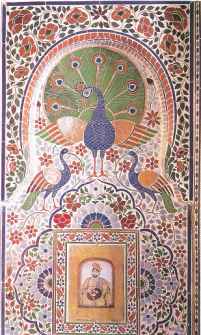 JAIPUR JAIPUR
My first stop in Rajasthan, after an 18 hour train journey travelling
north from Bombay, was in the capital city of Jaipur. With Ajmeri Gate as
the starting point, we explored the city's various bazaars on foot.
(Johari Bazaar - the famous jewellers' market, Tripolia bazaar or the
market where you could buy hand-printed cotton fabrics, and assorted shops
selling camel skin mojri slippers with traditional upturned toes,
perfumes or attars, crushed from roses, jasmine, musk etc). Jaipur
is a bustling city of noisy, broad crowded avenues and attention catching
architectural structures. Built on a dry lake bed surrounded by barren
hills, it is an extremely colourful place and has 1.5 million inhabitants.
Indian cities, by and large, suffer from the ill-effects of bad planning,
rapid inflow of immigrants from villages, slow action and apathy on the
part of those in power, .. the results are a bit depressing - on the
flip side, I saw serious traffic, (though organised in all its chaos!),
overcrowding, pollution, and sanitation problems in Jaipur. The city, I
found was best explored on foot, and though I had to fight for my place as
a pedestrian on the road with cars, rickshaws, bicycles, camel and bullock
carts all around, it was all in all, a very eventful, exciting outing!
The Old City
Jaipur owes its name, foundation and its careful planning to the great
warrior-astronomer Maharaja Jai Singh II (1699-1744). This guy was one
smart dude - interested in astronomy, science, art & architecture, he
followed the principles of the Shilpa-Shastra, an ancient Hindu treatise
on architecture, designing the city around the concept of nine
architectural blocks, symbolising the nine planets of the universe. Two of
these blocks were devoted to the Maharaja's own palace, the City Palace.
The City Palace What blows your mind away is the fabulous history on
display in cities like these. The scale and conception of this palace
gives you some idea of the power and wealth of the old maharajas, while
the collection of royal heirlooms on display in the palace museum fill in
the details of their lifestyle: sumptuous brocade robes, bloodthirsty and
bizarre weaponry studded with precious stones and cast in gold and silver,
carpets, priceless 500-year old miniature paintings - from the Mughal,
Rjasthani and Persian schools. I was fascinated by the ancient manuscripts
on display (I saw some 4th century A.D. manuscripts, a 16th century
translation of Aristotles book in Urdu and Jai Singh's translations
in Arabic and Sanskrit of the astronomical treatises of ancient scientists
displayed in glass cases). In one pavilion, there were two five-feet tall,
solid silver holy water urns, listed in the Guinness Book of World Records
as the largest silver objects in the world.
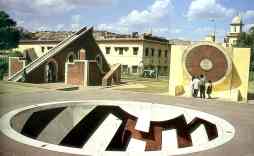
The Jantar Mantar Observatory
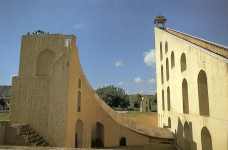 Of
the 5 observatories in India, this is the largest. Of
the 5 observatories in India, this is the largest.
Built by Jai Singh II next to the City Palace, this incredible 18th
century observatory includes a sundial with a 30m high gnomon, whose
shadow moves up to 4 meters an hour.
The instruments are not unlike gigantic, futuristic sculptures chiselled
in stone, one measuring up to 89 feet high and 148 feet wide, and still
marking time accurate up to 1 second!
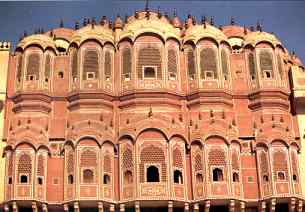 Hawa
Mahal (Palace of the Winds) Hawa
Mahal (Palace of the Winds)
Another exquisite landmark, exactly 200 years old, this five storey
building, which looks out over a broad street lined with little shops in
the old city, is made of pink sandstone. Through these semioctagonal and
narrow honeycombed windows, ladies of the royal household peeked at the
goings-on in the city below, without the possibilty of being observed
themselves .. rather like precious birds in gilded cages, I'd think ...
 Amer
Fort Amer
Fort
An interesting drive out of Jaipur, about 11 kilometres away, I
visited the 16th century Amer Fort. This was once the ancient capital of
Rajasthan. Built on the hills that surround Jaipur, surrounded by the
Maotha Lake on one side, where a herd of elephants bathed, it boasts of
large, complex gateways, courts, stairways, pillared pavilions and
palaces. This complex was built by Raja Man Singh, Mirza Raja Jai Singh
and Sawai Jai Singh, over a period of about two centuries. The fort is
surrounded by miles of ramparts that snake across the hills, broken by
massive bastions and watchtowers.
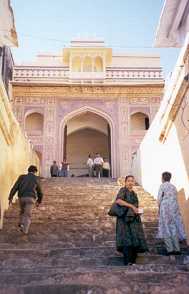 Once
past the ticket counter and inside the massive fortified gates, I
discovered a vast courtyard, featuring a magnificent, pillared hall
- the Diwan-i-Am, built of red sandstone, and the two-storeyed painted
gateway - the Ganesh Pol. Once inside this gate, I walked through what
once were palaces and formal gardens, set with pools, fountains and water
channels (providing an ingenious medieval "air conditioning" system that
cooled the rooms by amplifying the hill breezes and passing them over
channels of perfumed water). Once
past the ticket counter and inside the massive fortified gates, I
discovered a vast courtyard, featuring a magnificent, pillared hall
- the Diwan-i-Am, built of red sandstone, and the two-storeyed painted
gateway - the Ganesh Pol. Once inside this gate, I walked through what
once were palaces and formal gardens, set with pools, fountains and water
channels (providing an ingenious medieval "air conditioning" system that
cooled the rooms by amplifying the hill breezes and passing them over
channels of perfumed water).
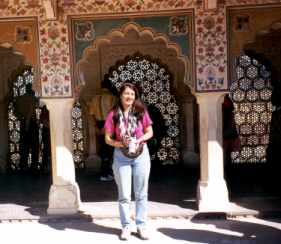
But nothing was to prepare me for the Sheesh Mahal (Mirror Palace),
its walls sparkling with intricately patterned mosaics of mirror-work and
coloured glass. Though I didn't have a candle at hand, it is said, that
when one is lit in the darkness here, it creates a magical and infinite
starscape of reflected pinpoints of light. The Jas Mandir, perched on the
upper floor, is a superb amalgam of the Mughal and Rajput style of
architecture, as is evident from the exquisitely carved 'jali' screens,
and fine mirror and stucco work.
Jaigarh Fort:
Jaigarh stands just behind the Amer Fort. Recently opened to the
public, it was sealed for seven years, due to a rumour, that an enormous
treasure in gold was buried, in the fort area. It has a gigantic
16th century Jaivana cannon, the largest of its kind in the world, 20 feet
long, 9 feet high, and so heavy that according some info I read, it needed
four elephants to swivel it around on its axis. Though I did not see it,
but at the village of Chaksu, nearly 30 miles south of here, you are shown
a spring of water which is said to have gushed out of the earth on the
impact of one of Jaivana's mighty cannonballs!
How to make your wallet lighter in Jaipur:
In Jaipur, precious and semiprecious stones are a reasonable buy. Other
good buys -- meenakari enamelled jewellery, chunky silver jewellery sold
by weight, miniature paintings, traditional Rajasthani mojri slippers,
carpets, blue pottery and bright hand printed cotton fabrics, embroidered
work. |